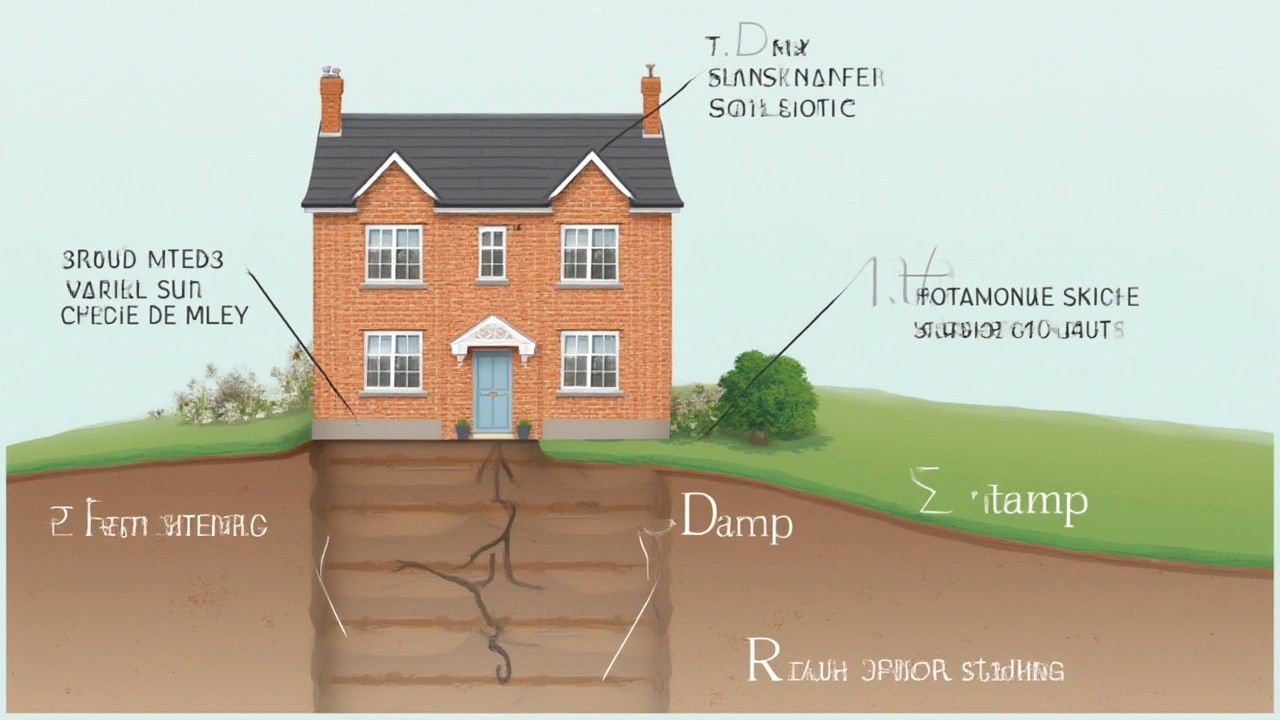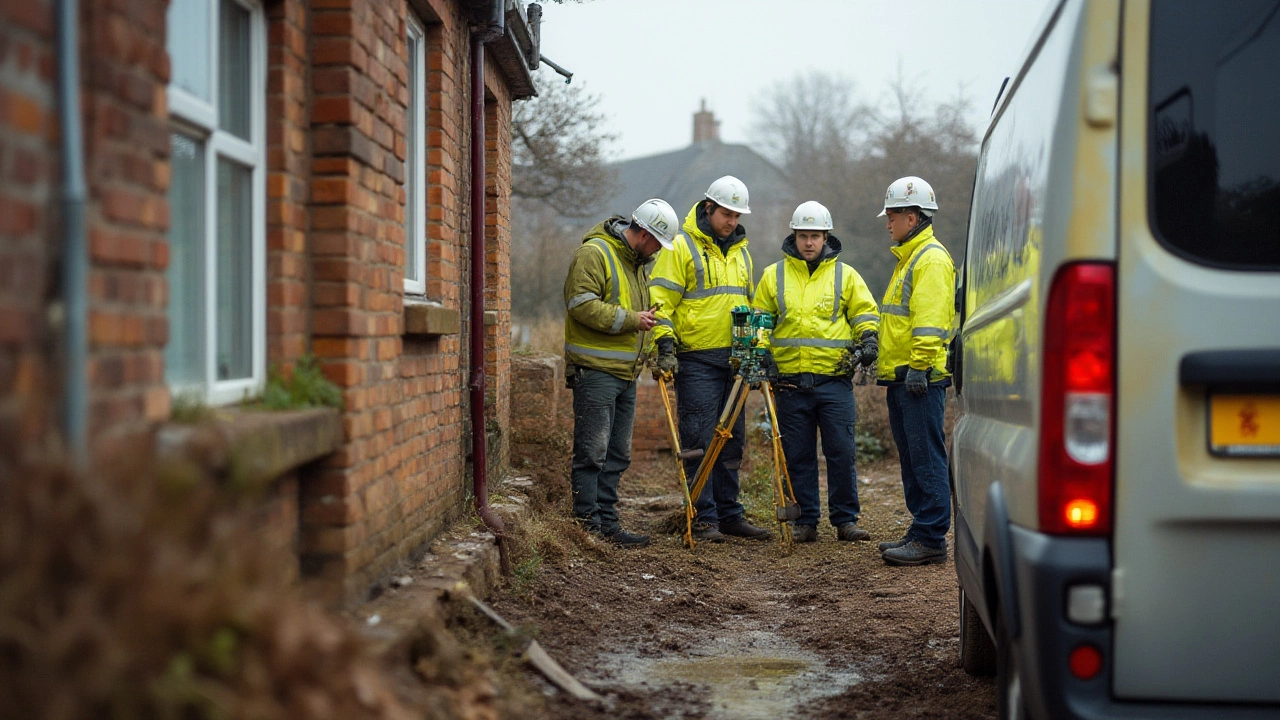Buying a house is risky enough—finding out the foundation is shot is the kind of nightmare nobody wants. Yet here’s the thing: right now in the UK, more than 20,000 homes every year get flagged for some kind of foundation problem. Subsidence was up 33% in southern England after the blistering heatwaves of 2022 and 2023, and Bristol’s clay-rich soils don’t play fair. There are cracks that keep spreading, doors that wedge shut, floors that sound hollow. Selling gets tricky and insurance companies ask the tough questions. So, can a house with a bad foundation actually be rescued? Or is it time to cut and run?
How to Spot Trouble: The Signs & Causes of a Bad Foundation
Most people imagine a bad foundation as something dramatic: deep cracks racing up the walls, the house tilting like Pisa’s Leaning Tower. Truth is, trouble often sneaks up quietly. Spotting the early signs can save you thousands in repairs or keep you from buying into a money pit. Doors that used to open smoothly grind tight or don’t latch. Windows refuse to move or have gaps appearing around their frames. Outside, you might see stairstep cracks in brickwork, or notice the ground near exterior walls pulling away. Inside, floors slope, bounce, or feel odd underfoot—sometimes causing furniture to slide on its own.
So why does it happen? The usual culprits in the UK are shifting soils—especially clay-heavy ones that shrink and swell with changes in moisture. Add in heavy rain, tree roots sucking the ground dry, leaking drains, or poor site drainage, and you’ve got a recipe for disaster. Around Bristol, nearly 60% of reported foundation problems trace back to water management or root issues. Some older homes, built before modern building regs, suffer because they simply weren’t designed to today’s structural standards.
Here's a quick checklist that surveyors use (and so can you):
- Horizontal or diagonal cracks wider than a 5p coin, especially around doors and windows
- Uneven floors or obvious slopes, sometimes visible with a marble test
- Gaps between walls and ceilings or floors
- Porches or extensions pulling away from the main house
- Visible separation at exterior wall corners
- Sticking doors/windows that never used to be a problem
- Bulging, bowing, or leaning foundation walls in basements/cellars
Let’s be straight—cracks that are hairline or less than 1-2mm wide usually aren’t a huge worry. It’s the pattern, location, and whether they’re growing that matters most. Subsidence often leaves tell-tale diagonal cracks, wide at the top and narrow at the bottom, whereas settlement can cause vertical cracks between bricks or blocks.
If you’re already worried, a structural engineer’s report is your next step. Unlike a general homebuyer’s survey, this report digs into soils, moisture levels, and underlying movement. Costs in the UK run between £300 and £1,000 depending on the survey complexity. Some home insurance policies will foot the bill if you’re already seeing obvious structural movement.
Here’s something that shocks most people: about 50% of “foundation problems” turn out to be routine settlement or even just cosmetic. But ignoring real movement is a shortcut to disaster, especially once water finds a way inside.

Fix or Flee? Assessing Repair Options For A Bad Foundation
The million-pound question: should you shell out for repairs, or cut your losses and walk away? Repairing a bad foundation is one of the most disruptive—and expensive—jobs in construction, but not always impossible. The right fix depends on what’s failed and why.
Here are the main repair routes in the UK, with typical situations and costs:
| Repair Method | How It Works | Approximate Cost (2025) | Typical Scenario |
|---|---|---|---|
| Underpinning | Excavate beneath the foundation and add deeper supports | £8,000 - £35,000 | Major movement/subsidence, especially on clay soil |
| Mini-piling | Steel piles drilled deep to bypass weak soil | £15,000 - £50,000 | Serious subsidence, poor ground, close neighbours |
| Resin injection | Expanding resin or grout stabilizes soil | £3,000 - £15,000 | Minor settlement, low-weight structures |
| Crack stitching | Metal rods and epoxy used to stabilise cracked walls | £1,200 - £3,000 per wall | Isolated cracks, walls still plumb |
| Drainage improvements | External drains, soakwells, grading | £2,000 - £10,000 | Ongoing water problem, tree roots |
Underpinning is what most people think of—big holes, propping up the house, serious mess and months of work. Mini-piling is even more robust, skipping poor soils altogether. Resin injection attracts a lot of buzz due to its speed, but it’s not for every house; if the whole building is moving, you need something with muscle. Crack-stitching only helps when the structural movement is minor and well-understood.
The bad news? You can’t always pop in for a cheap fix. Insurance companies, especially after the wave of subsidence claims in the last two years, demand proof the movement has stopped. Sometimes, repairs require digging trial holes, conducting soil tests, installing monitoring equipment—extending the timeline by months. Older homes, especially Victorian terraces around Bristol, may need underpinning to half a dozen properties at once if the problem affects shared party walls. Expect blue tarps, scaffolding, and weeks of mud. Welcoming, right?
But here’s where good news sneaks in. About 70% of UK houses with moderate foundation problems are successfully repaired every year. Most don’t collapse or need demolition. Properties with well-documented repairs—especially when underpinned or pile-stabilised and with long-term monitoring—actually sell for full market value within a few years after works are finished. Lenders do care, but if you keep paperwork and post-repair certification, you’re in a strong position to sell or remortgage later.
Repairs aren’t just about brute force. Controlling water is half the battle. Too many times, failed gutters, leaking pipes, or poor grading cause the drama. Directing rainwater away, removing deep-rooted trees near the foundation, and fixing drains resolve a surprising number of underlying issues, sometimes without any intrusive works.
- Tip: Check your rainwater downpipes and drains every autumn for blockages. A 2023 RHS survey found over 40% of foundation issues in older UK homes started with simple gutter overflow!
- Tip: Keep mature trees at least 10 metres from the house, especially with clay soils. London Plane and Oak are notorious for drying ground and shifting foundations.
- Tip: Any repairs involving soil or structure changes need sign-off by a chartered surveyor or structural engineer. Without official paperwork, your house will likely be unsellable.
The cost of “fix or flee” can get emotional. Repairs can easily hit £30,000—sometimes more for big corner plots or listed properties. But walking away usually means selling at a deep discount. Unless the house is literally unsafe to enter, foundations can nearly always be saved if you’re realistic about budget and disruption.

Living With (and After) Foundation Repair: What to Expect
People think getting a foundation fixed is the end of their home headaches. Not quite. Living through foundation repairs is messy, noisy, and nerve-wracking. You’ll have teams digging right up to the walls—in some cases, inside the living room. Floors can be lifted, gardens wrecked, and family routines flipped. Dust, mud, and intermittent thuds from jackhammers or piling rigs become your daily background noise. Most jobs take four to twelve weeks, not counting the diagnostic surveys that can stretch out over months if you need long-term vibration or moisture monitoring.
For repairs inside (say, in a basement), you might have to shift everything out or cover it with sheeting. Sockets and wiring sometimes get moved. While builders do their best to contain dust, expect a thin layer to settle on shelves every single day no matter how tidy they promise to be. Kids and pets need wrangling far away from the chaos—a challenge in itself. Most people stay in the house during repairs, but it’s not for the faint-hearted. If major sections of floor need lifting, or if you’re underpinning an entire perimeter, it might be worth budgeting for a short let nearby just to stay sane.
Once the physical work is done, monitoring begins—sometimes for up to a year. Engineers track if new cracks stop widening, and if moisture readings in the soil stabilize. Insurers will want to see these reports before concluding the claim is shut. Once signed off, add these to a home information pack for future buyers or remortgage applications. A survey by the HomeOwners Alliance in 2024 found 83% of buyers would still consider a house with historic foundation repairs—provided the paperwork is clear, the problem is fixed, and warranties are in place.
What about the money? Foundation repairs aren’t always covered by standard buildings insurance. Insurers often demand a full review, so if you’ve just discovered a big problem, call them straight away but don’t start work without their agreement. Policy excesses for subsidence claims can run £1,000-£2,500, with renewal prices rising, but getting cover elsewhere post-repair is usually possible with transparent documentation. Some builders offer 10- or even 20-year guarantees for underpinning or piling work, so make sure you check what’s on offer—especially if you aim to sell.
Here are a few practical tips for living happily after repair:
- Keep all paperwork, warranties, engineer’s reports, and before/after photos together in a dedicated folder. Digital and paper. You’ll need it at some point.
- Install French drains or extra guttering early—foundation problems are often made worse by unchecked water flow.
- Stay on top of trees, especially after the repair. Scheduled root pruning in mature gardens helps, but new planting should be small and kept well away from the house perimeter.
- If you’re renting or selling, transparency is key. Buyers aren’t shy about foundation history any more, provided the repairs are proper and certified.
- After major underpinning, allow a year before embarking on cosmetic redecorations. Sometimes minor shrinkage cracks appear as the house settles back down.
So yes, a house with a bad foundation usually can be saved—with planning, the right budget, and a bit of grit. Don’t panic, don’t hide the problem, and don’t wait for the floors to wave hello before acting. Bristol’s oldest homes survived centuries by being adaptable; modern houses, given decent repairs, can last just as long. If you spot those warning signs, act quickly—saving your home starts at the ground up.





